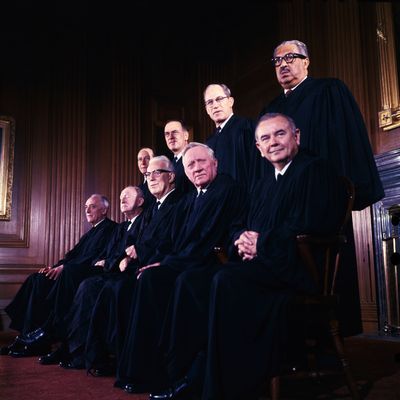
It’s a commonplace observation that control of the future shape of the Supreme Court is one of the high-stakes consequences of the 2016 presidential election. That’s partly because the Court is currently at an ideological equipoise, with four generally liberal and four conservative justices (though Anthony Kennedy is not as easy to classify) presently serving, with one vacancy that Hillary Clinton or Donald Trump will likely get to fill.
But another reason 2016 could be big is that true domination of the Supreme Court by one party or ideology takes time, and usually consecutive presidencies of the same party. A Clinton presidency following an Obama presidency could do the trick.
That would be a really unusual opportunity for the Donkey Party, which has not had more than eight consecutive years of controlling the White House since Harry Truman left office. Republicans have had vastly better luck in securing SCOTUS nominations. Indeed, because Jimmy Carter did not have a single SCOTUS vacancy to fill, Republican presidents appointed an astonishing ten consecutive justices between 1969 and 1991. The only reason this did not produce a profoundly conservative SCOTUS era is (as any conservative, and especially Christian conservative, will tell you) that multiple Republican-appointed justices turned out to be relatively liberal on certain issues (notably abortion) or liberal altogether (e.g., John Paul Stevens and David Souter).
As Dylan Matthews explains at Vox, a second President Clinton (especially if she won a second term) would have a good shot at creating the first unambiguously liberal Court since 1971, and perhaps a 6-3 liberal majority on SCOTUS in fairly short order. Aside from stopping a conservative trend on the Court in areas ranging from campaign-finance reform to business regulation to labor law, such a development could lead to progressive constitutional landmarks unimagined for decades, such as prohibitions on mass incarceration and establishment of a truly national right to vote without state and local obstruction and harassment.
It is theoretically possible, of course, that Clinton appointments could disappoint liberals the way Nixon and Ford and Reagan appointments have disappointed conservatives. But probably not: The brouhaha over “treacherous” Republican justices has made it vastly more acceptable to vet potential nominees carefully for their past record and their judicial philosophy. There may be some doubt about what Donald Trump will do in the way of shaping the Supreme Court in a coherent manner. But Hillary Clinton’s direction in judicial appointments should be clear enough, and will probably motivate an unprecedented degree of conservative resistance in the Senate and beyond.






























